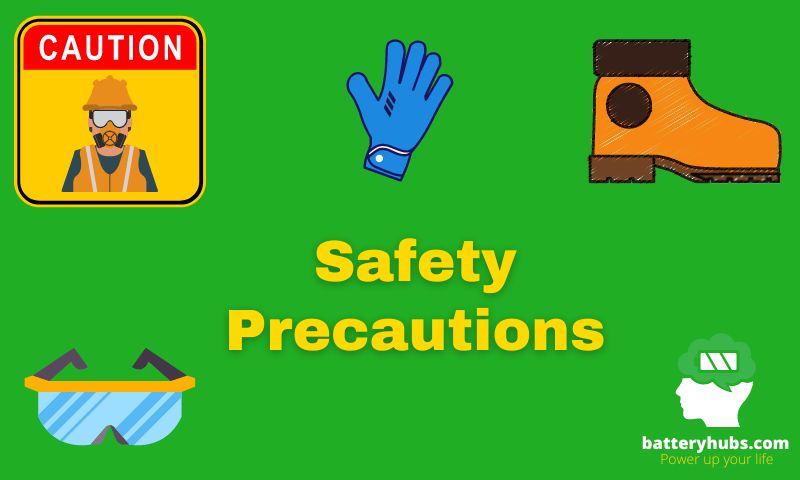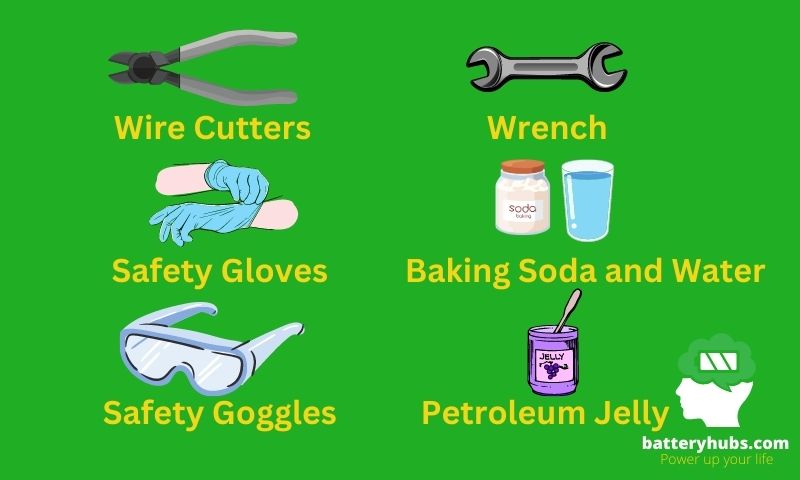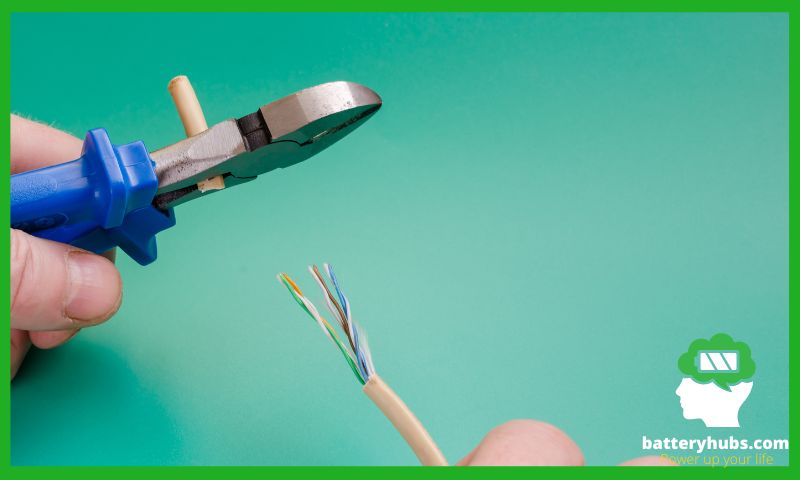To cut a battery cable, first, ensure safety by disconnecting the battery. Use heavy-duty wire cutters to cut the cable. If the cable has insulation, make a circular cut around it with a utility knife and then remove it. Always remember, proper tools and safety precautions are essential in this process.
I’m thrilled you’ve joined me on this electrifying journey. You see, I’ve spent a good chunk of my life tinkering with cars, boats, and just about anything with a battery. And let me tell you, I’ve cut more battery cables than I can count. It’s a task that might seem daunting at first, but with the right tools and a dash of know-how, it’s as easy as pie.
Now, I’ve seen all sorts of methods for cutting battery cables, some safer than others. But I’m here to share with you the safest and most effective way I’ve found. It’s a method that’s served me well over the years, and I’m confident it’ll do the same for you. So, buckle up, and let’s dive into the electrifying world of battery cables!
What You Need to Know Before Cutting a Battery Cable?
Now that we’ve covered the basics of what you need to know before cutting a battery cable, let’s delve into the safety precautions you should take when dealing with battery cables to ensure a safe and successful process.
Safety precautions when dealing with battery cables

Before you even think about cutting a battery cable, safety should be your top priority. Batteries contain acid and can produce explosive gases, so it’s crucial to take precautions.
Always wear protective gear, including gloves and safety glasses. Make sure the area is well-ventilated, and never smoke or create a spark near a battery.
When disconnecting the battery, always remove the negative terminal first. This reduces the risk of a spark that could ignite any hydrogen gas emitted by the battery. Once the battery is disconnected, you can proceed to cut the cable.
Importance of disconnecting the battery before cutting the cable
Disconnecting the battery before cutting the cable is not just a safety measure, it’s a necessity. Cutting a live battery cable can cause a short circuit, potentially damaging the battery and other electrical components in your vehicle. It could also cause a spark, leading to a fire or explosion if there are any flammable substances nearby.
When disconnecting the battery, remember to remove the negative terminal first. This is because the negative terminal is connected to the car’s body, and removing it first reduces the risk of a short circuit.
Cutting a battery cable may seem like a simple task, but it’s not something to be taken lightly. Always prioritize safety and make sure to disconnect the battery before you start. And remember, if you’re not comfortable doing this yourself, it’s always best to seek help from a professional.
Tools Needed for Cutting a Battery Cable
As someone who’s been elbow-deep in engines and batteries for years, I can tell you that having the right tools for the job makes all the difference. When it comes to cutting a battery cable, you’ll need a few specific tools to get the job done safely and effectively.
List and Description of Necessary Tools

Wire Cutters: This is your main tool for the job. A good pair of wire cutters will allow you to cut through the battery cable cleanly and easily. Make sure they’re sturdy and sharp!
Safety Gloves: Safety first, folks! When dealing with car batteries, it’s crucial to protect your hands. A pair of thick, rubber gloves will do the trick.
Safety Goggles: Again, safety is key. Battery acid is no joke, and the last thing you want is any splashing near your eyes. Always wear safety goggles when working with car batteries.
Wrench: Depending on the terminal configuration of your battery, you’ll need either a 5/16-inch (8 mm), 3/8-inch (10 mm), or 1/2-inch (13 mm) wrench to loosen the cable nuts.
Baking Soda and Water: This might seem like an odd one, but a mixture of baking soda and hot water is great for cleaning off any corrosion on the battery terminals.
Petroleum Jelly or Battery Terminal Protection Spray: After you’ve cut and cleaned your battery cable, it’s a good idea to apply some petroleum jelly or a battery terminal protection spray to prevent future corrosion.
Remember, folks, working with car batteries can be dangerous, so always prioritize safety. Use the right tools, take your time, and you’ll be able to cut a battery cable like a pro.
Step-by-Step Guide to Cutting a Battery Cable

Hey there, battery enthusiasts! Today, we’re going to tackle a topic that might seem a bit daunting at first: cutting a battery cable. Now, I know what you’re thinking: “Isn’t that dangerous?” Well, with the right knowledge and precautions, it’s a task you can safely handle. So, let’s dive right in!
Safety Precautions
Before we get started, let’s talk safety. When dealing with batteries, it’s crucial to wear the appropriate protective gear. This includes safety glasses and gloves. Car batteries contain a mixture of sulfuric acid and water that could cause serious harm if it gets into your eyes or on your skin. So, always remember: safety first!
Disconnecting the Battery
The first step in cutting a battery cable is to disconnect the battery. This might seem like a no-brainer, but you’d be surprised how many people forget this step and end up with a shocking surprise.
To disconnect the battery, you’ll need to remove the negative cable first, then the positive cable. This will ensure that the car’s electrical circuit is broken and you won’t get an electrical shock when cutting the cable.
Cutting the Cable
Once the battery is disconnected, you’re ready to cut the cable. To do this, you’ll need a hacksaw and a firm grip. Hold the cable securely with a pair of slip-joint pliers and saw it off right where it exits the battery terminal. Remember, don’t see it off while it’s still on the battery. That’s a recipe for disaster.
Replacing the Cable
After cutting the cable, you’ll likely need to replace it with a new one. When choosing a new cable, make sure it matches the old one in length and has the same terminal connectors at each end.
Once you’ve got your new cable, you can attach it to the battery, starting with the positive cable and then the negative.
Testing the Connection
Finally, it’s time to test your work. Start the car and see if everything runs smoothly. If the car fails to start, one of the cables may not be properly fastened, or the battery may not have enough charge. If everything works as it should, give yourself a pat on the back. You’ve successfully cut and replaced a battery cable!
And there you have it, folks! A step-by-step guide to safely cutting a battery cable. Remember, working with batteries can be dangerous, so always take the necessary precautions and don’t rush the process. Stay safe and happy tinkering!
Today, we’re going to tackle a topic that might seem a bit daunting at first: cutting a battery cable. Now, I know what
How to Replace a Cut Battery Cable?
Hello, fellow battery buffs! Today, we’re diving into the nitty-gritty of replacing a cut battery cable. Now, I know it sounds like a daunting task, but trust me, with the right guidance and a dash of elbow grease, you’ll be able to do it like a pro. So, buckle up, and let’s get started!
Step 1: Safety First
Before we start, remember to put on your safety glasses and gloves. Working with batteries can be a bit risky, and we don’t want any acid splashes or electrical shocks, do we?
Step 2: Disconnect the Battery
First things first, disconnect the battery. Start with the negative cable, then move on to the positive one. This ensures that the car’s electrical circuit is broken, and you won’t get an unpleasant surprise when you start working on the cable.
Step 3: Remove the Damaged Cable
Now, it’s time to remove the damaged cable. You can do this by loosening the bolt on the battery terminal and then pulling the cable off. If the cable is stuck, don’t yank it. Instead, use a battery terminal puller to avoid damaging the battery post.
Step 4: Prepare the Replacement Cable
Next, prepare your replacement cable. Make sure it’s the same length as the old one and has the same type of connectors. If the connectors are different, you might need to use a battery terminal crimper to attach the correct ones.
Step 5: Install the New Cable
Now, you’re ready to install the new cable. Attach it to the battery, starting with the positive terminal and then the negative. Make sure the connections are tight and secure.
Step 6: Test the Installation
Finally, test your installation by starting the car. If everything is working properly, congratulations! You’ve successfully replaced a cut battery cable.
Importance of Choosing the Right Replacement Cable
Choosing the right replacement cable is crucial for the performance and safety of your vehicle. A cable that’s too short or too thin might not be able to handle the current from the battery, leading to poor performance or even a fire risk.
On the other hand, a cable that’s too long or too thick can be difficult to install and might end up getting damaged.
So, always make sure to choose a replacement cable that matches the specifications of the original one. If you’re unsure, don’t hesitate to consult a professional.
And there you have it, folks! Replacing a cut battery cable might seem like a big task, but with the right steps and precautions, it’s something you can definitely handle. Remember, safety first, and happy tinkering!
Tips for Maintaining Battery Cables
Maintaining your battery cables is just as important as maintaining the battery itself. Proper care can prolong the life of your cables, prevent the need for cutting, and ensure your vehicle’s electrical system functions optimally. Here are some tips to help you keep your battery cables in top shape:

Regular Inspection
Make it a habit to inspect your battery cables regularly. Look for signs of wear and tear, corrosion, or damage. If you notice any, it might be time to replace your cables.
Clean Your Battery Terminals
Corrosion on battery terminals can hinder the flow of electricity. Cleaning your battery terminals regularly can prevent this. You can use household items like baking soda and water to clean your battery terminals. Alternatively, there are professional-grade supplies available in the market for this purpose.
Here’s a step-by-step guide on how to clean your battery terminals:
- Remove the battery terminals: Disconnect both the positive and negative cable ends from the battery. Always start with the negative cable.
- Clean the battery with household items: Sprinkle baking soda over both battery terminals. Pour a couple of tablespoons of water into each terminal. The baking soda will react with the water, neutralizing the acid and making it safe to handle. Scrub the terminals with a stiff brush, rinse with water, and let the battery dry completely.
- Clean the battery with professional-grade supplies: Spray the cable ends and the terminals with battery cleaner spray. Let it soak for a few minutes, then rinse the battery completely with water. Clean the battery posts and cable ends with a battery brush.
- Reconnect the battery terminals: Replace the positive battery cable end back on, then do the same for the negative cable. Tighten the nut on the clamp until it is snug, then add another quarter turn.
Use a Battery Terminal Protector
After cleaning your battery terminals, consider using a battery terminal protector spray or a thin layer of petroleum jelly. This will protect the terminals from corrosion and ensure a good connection.
Replace Damaged Cables
If you notice that your battery cables are damaged or worn out during your regular inspections, don’t hesitate to replace them. Damaged cables can cause a variety of problems, including difficulty starting your vehicle and reduced battery life.
Remember, prevention is better than cure. Regular maintenance of your battery cables can save you from unexpected troubles and expenses in the long run.
Conclusion
Cutting and replacing a battery cable may seem like a daunting task, but with the right tools and a bit of know-how, it’s something you can do yourself. Remember, safety should always be your top priority when dealing with car batteries. Always disconnect the battery before cutting the cable and wear protective gear. Regular maintenance of your battery cables can also go a long way in preventing the need for cutting. By following these tips, you’ll not only save money on mechanic fees but also gain valuable skills.
In addition to cutting and replacing battery cables, it’s also important to understand why certain issues occur. For instance, have you ever wondered why battery cables get hot? Or what size bolt is typically used for a battery terminal? These are just a few of the many questions you might encounter when dealing with car batteries.
Moreover, regular maintenance is key to prolonging the life of your battery cables. For example, did you know that you have to disconnect the battery to clean the terminals? And that there’s a specific substance you can put on battery terminals to prevent corrosion?
By educating yourself on these topics, you’ll be better equipped to handle any battery-related issues that come your way. Remember, knowledge is power – especially when it comes to DIY car maintenance. Keep learning, keep exploring, and most importantly, keep having fun with it!
FAQ
What tools do I need to cut a battery cable?
To cut a battery cable, you’ll need a few key tools: a pair of heavy-duty wire cutters or a cable cutter, safety gloves, and safety goggles. It’s also helpful to have a wrench set on hand for removing the battery terminals.
Is it safe to cut a battery cable?
Cutting a battery cable can be safe if done correctly. However, it’s important to disconnect the battery first to avoid any electrical shocks. Always wear safety gloves and goggles, and ensure the vehicle is off before starting the process.
How do I replace a cut battery cable?
Replacing a cut battery cable involves removing the old cable, cleaning the battery terminals, and installing a new cable. It’s crucial to choose a replacement cable of the right gauge and length for your vehicle to ensure proper functioning.
Can a cut battery cable affect my vehicle’s performance?
Yes, a cut or damaged battery cable can affect your vehicle’s performance. It can cause issues with power transmission, leading to difficulties in starting the engine, dim headlights, or even complete power loss.
How can I prevent my battery cables from needing to be cut?
Regular maintenance and inspection of your battery cables can help prevent the need for cutting. This includes checking for corrosion, ensuring the cables are securely connected, and replacing any damaged cables promptly. Using a battery terminal protector can also help prevent corrosion and prolong the life of your cables.
